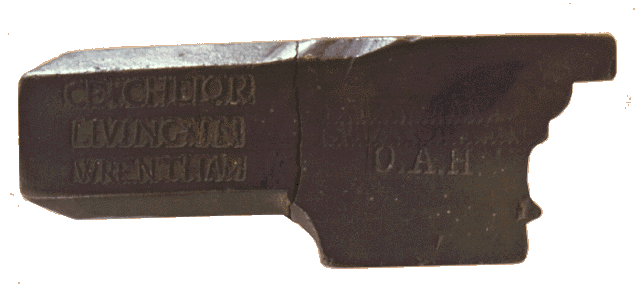We may receive a commission when you use our affiliate links. However, this does not impact our recommendations.

Picture from Joel’s website (linked below)
When I first began collecting antique wooden planes, the name Cesar Chelor was an oft told inside joke. Chelor was a mid 18th c planemaker. He was owned by New England planemaker Francis Nicholson. When Nicholson died in 1753, he freed Chelor, providing him with land, and tools.
“As to my Negroman Caesar Chelo[r] considering his faithful service, his tender care, & kind & Christian carriage I do set him free to act for himself in the world & I do will and bequeath unto him his bed and beding, his shift and clothing, his bench & common bench tools, a set of chisels, one vice, one sithe & tackling & ten actes of land to be set of to him at the end of my woodland…¦& one third part of my timber.”
From Joel’s website (thanks Joel)
Chelor continued making planes, stamping them with his own name. Today, these rare planes are among the best known and most valuable antique wooden planes on the market. A single plane can be worth thousands of dollars. Finding one among a box of dirty planes with rusty irons is the hope of every collector. They are the proverbial diamond in the ash can. Collectors often joke that they bought a box of duds for $5 only to find a Chelor (gloat gloat). Or that uninitiated collectors who got some woodies in a box lot with a crispy (good condition) Stanley 45 should send all those marked “Chelor” to famed internet tool dealer Todd Hughes, who will know how best to dispose of them (selling them for thousands of dollars).
For this reason, Chelor deserves the honored top billing for Woodworking Black History Month. The story of his bondage, freedom, and subsequent business success is such an American tale. The best part about it is that it reminds us that Black History is really American history. Chelor deserves the attention he gets because he reminds us that a hard working woodworker can overcome any adversity.
To learn more about Chelor, google him or start here at my friend Joel’s website.
Adam
P.S. Note the use of the term “shift” in Nicholson’s will. I believe this was the word used for the long (often unisex) shirt worn by people of the 18th c and before. I’ve used this term before and had people look at me funny. Not sure when “shirt” took over for “shift”.
Here are some supplies and tools we find essential in our everyday work around the shop. We may receive a commission from sales referred by our links; however, we have carefully selected these products for their usefulness and quality.








A shift, as the term was used in the period mentioned, was a loosely-fitting undershirt or, in the female case, a chemise.
It wasn’t a shirt, which was called a "shirt".
Zio/
Hello, I’m new to woodworking and hence, new to this site. Can anybody tell me how to access the archives of this blog? I don’t see a link anywhere. Unfortunately, my blog reader only goes back to March 24, 2009.
Thanks!
Adam, come on out for a Southeast Michigan Woodworkers (SEMIWW.org) Galoot faction meeting and make stamps with us. We have a couple of members with reverse-letter stamps. We stamp our names/initials/whatever into a piece of annealed O1 steel and file out the edges with a saw file to create the border. They work great in end grain and are pretty easy to make. This was one of our monthly meeting projects and there is interest in doing it again.
If you ever wind up in the Detroit area on the first Thursday of the month, look us up. 🙂 That’s an open invitation to Galoots everywhere.
Chris once wrote on one of the last pages in Woodworking Magazine, about a small stamp that his wife gave to him. That could be a solution.
Yeah. They marked the front end of planes. Kinda interesting really. This sort of stamp was purposefully designed to stamp end grain. They stamped the toe because the heel got smacked with a hammer or mallet to loosen the wedge. Sometimes you see the owners’ marks on the heel and the makers’ on the toe. I tried making my own name stamp out of a cold chisel by using a dremel tool and tiny files and scrapers. It was a disaster. First, my name is way too long to stamp any planes. Planemakers need shorter names. Second, I wrote my name on the bottom of the cold chisel and removed the negative space (to make a long grain stamp). What resulted was a perfectly clear stamp that was BACKWARDS. I made one more stamp that worked but I hated it so I abandoned it.
Adam
OK. After reading the article from the link I discovered that it was actually the front end of the plane and not the iron. Fascinating stuff by the way.
I’m thinking that’s an owner’s stamp. Pretty sure that plane belonged to the famous Italian craftsman Obidiah Abraham Horowitz.
Okay, so I lied. I have no idea who owned it, but I’m thinking it IS an owner’s mark. Extra points for the wittiest name to fit the initial O.A.H. My daughter Genevieve gets the points for this one.
Adam
What is the meaning of the letters O.A.H that are stamped in the plane iron?
Adam, I’m glad you put the definition of "shift" as a PS because I thought it was the 18th century colloquial way of saying "stuff" and that we had just lost the ‘f’ from it.